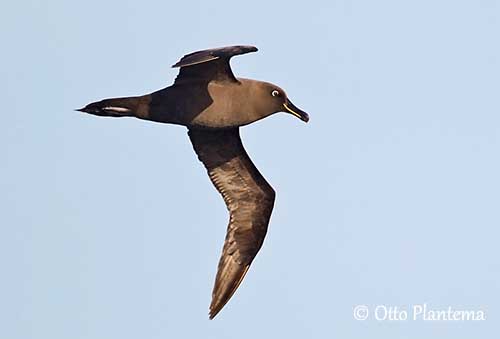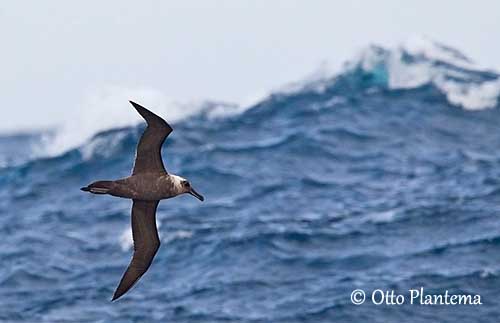
Fr: Albatros brun
Ang: Sooty Albatross
All: Rußalbatros
Esp: Albatros Ahumado
Ita: Albatro fuligginoso
Nd: Zwarte Albatros
Sd: Vanlig sotalbatross
Photographer:
Otto Plantema
Trips around the world
Text by Nicole Bouglouan
Sources:
HANDBOOK OF THE BIRDS OF THE WORLD vol 1 by Josep del Hoyo-Andrew Elliot-Jordi Sargatal - Lynx Edicions - ISBN: 8487334105
A Complete Guide to Antarctic Wildlife by Hadoram Shirihai and Illustrated by Brett Jarrett - Edited by Guy M. Kirwan - ALUL.A Press Oy, Finland - ISBN 9519894705
BirdLife International (BirdLife International)
Australian Antarctic Division: Leading Australia's Antarctic Program
Wikipedia, the free encyclopaedia
Sooty Albatross
Phoebetria fusca
Procellariiformes Order – Diomedeidae Family
INTRODUCTION:
The Sooty Albatross is included in the genus Phoebetria alongside the Light-mantled Albatross (P. palpebrata). Both birds have dark plumage and look very similar. However, they differ in courtship displays and timing of breeding. Both differ from genus Diomedea in having more pointed and narrower wings, longer wedge-shaped tail and peculiar head pattern.
DESCRIPTION OF THE BIRD:
Biometrics:
Length: 84-89 cm
Wingspan: 200-203 cm
Weight: M: 2200-3250 g – F: 2100-2800 g
The adult has entirely sooty-brown plumage with browner head and neck and very dark face. Belly, wings and tail are variably darker whereas neck and body are slightly paler.
In worn plumage, hindneck to mantle can be much paler and contrast with the head. On the wings, the white shafts of the outer primaries are conspicuous, and can be seen even at distance.
The bill is black and shows yellowish-pink stripe on the sides of the lower mandible, but this stripe does not reach the bill tip. The eyes are dark grey to dark brown, surrounded by broad, white eyering, becoming narrower and broken on lores. Legs and webbed feet are pale pinkish to bluish-grey.
Both adults are similar, but the female is smaller than male.

The juvenile resembles adult but it shows narrow pale fringes, especially on head and mantle. Eyering and bill stripe are greyer. The shafts of the outer primaries are browner. The young bird may show buffish-grey collar on nape, neck sides and upper mantle.
RANGE:
The Sooty Albatross occurs in both South Atlantic and Indian Oceans off the coasts of South America, South Africa and Australia. This species breeds from Tristan da Cunha and Gough (the largest population), E to Kerguelen, (only a few pairs), Amsterdam and St Paul.
HABITAT:
The Sooty Albatross is pelagic and spends most of the year at sea. It comes to land only for breeding on remote islands. It nests among the vegetation on steep slopes and sea cliffs, often among tussock grass.
It frequents pelagic waters but forages in coastal kelp beds around its breeding islands.
CALLS AND SONGS:
The Sooty Albatross is usually silent at sea. However, it is more vocal at colonies. It utters the typical “sky call” with bill and head held upwards “pee-aahh”.
In defence behaviour against other albatrosses or humans, it gives a braying threat call. Bill clattering is common too, and is used both in courtship displays and territorial behaviour.

BEHAVIOUR IN THE WILD:
The Sooty Albatross feeds on squid, crustaceans, fish and carrion, and may scavenge bird carcasses floating at sea. It takes primarily cephalopods, but the preys vary according to the season.
The preys are caught mainly by surface-seizing and probably at night. It often forages and feeds alone or in small groups of 4-5 individuals, sometimes with other Diomedeidae species, or terns and shearwaters. It also feeds around the large marine mammals that lead the preys close to the surface.
This species is less often attracted by fishing boats than other albatrosses.
During the breeding season, it may travel up to 1200 kilometres from the colonies to find food.
The Sooty Albatross is usually solitary or in small groups, including at nesting colonies where scattered groups of only 50-60 pairs are common. It may also nest solitary.
Mates are monogamous with long-term pair-bonds that are renewed each season through complex displays at nest-site. The male arrives first, usually in mid-August. Once the female has arrived too, they perform long sequences of stereotyped postures, repeated several times.

In the pairs already formed, the displays are simpler. Both mates perform some greeting displays when they meet at the breeding site. The copulation occurs two weeks before the egg-laying.
They are highly territorial and defend strongly the nest-site.
After breeding, the adults disperse N in winter, leaving both subantarctic and Antarctic waters. The longitudinal distribution spreads usually from Argentina E to Tasmania, and occasionally to New South Wales, and sometimes Macquarie Island and New Zealand.
The species is vagrant to E Pacific. The immatures often remain in subtropical seas all year round.
The Sooty Albatross glides along on stiff wings, rising and falling alternately. It takes advantage of the wind speeds while reaching different heights.
During the long foraging trips, it can cover long-distances by dynamic soaring while using little energy.

REPRODUCTION OF THIS SPECIES:
The breeding season starts in July/August and runs until December. The colony is established among vegetation on steep slopes and sea cliffs on remote islands. The birds nest in small groups of 50-60 pairs or sometimes solitary.
The nest is a low, truncated conical structure made with moss, grass and mud. It is up to 20 centimetres high with a central depression often lined with grass.
The female lays a single white egg. Both adults share the incubation during about 65-75 days, with stints of 10-11 days. At hatching, the chick is covered with greyish down and has whiter face. It is brooded during the first three weeks, and fed by both parents by regurgitation every 2-4/2-6 days.
The young fledges between 145 and 180 days after hatching. It will be sexually mature between 9 and 15 years old.

PROTECTION / THREATS / STATUS:
The Sooty Albatross is threatened by longline fishing gear which is still used today in the Australian waters, and ingestion of hooks and plastic. The breeding failures are caused by introduced predators such as rats and cats on the breeding islands.
The population is estimated at about 28,000 mature individuals and decreasing.
The Sooty Albatross is currently considered Endangered, due to rapid decline over three generations (90 years).
